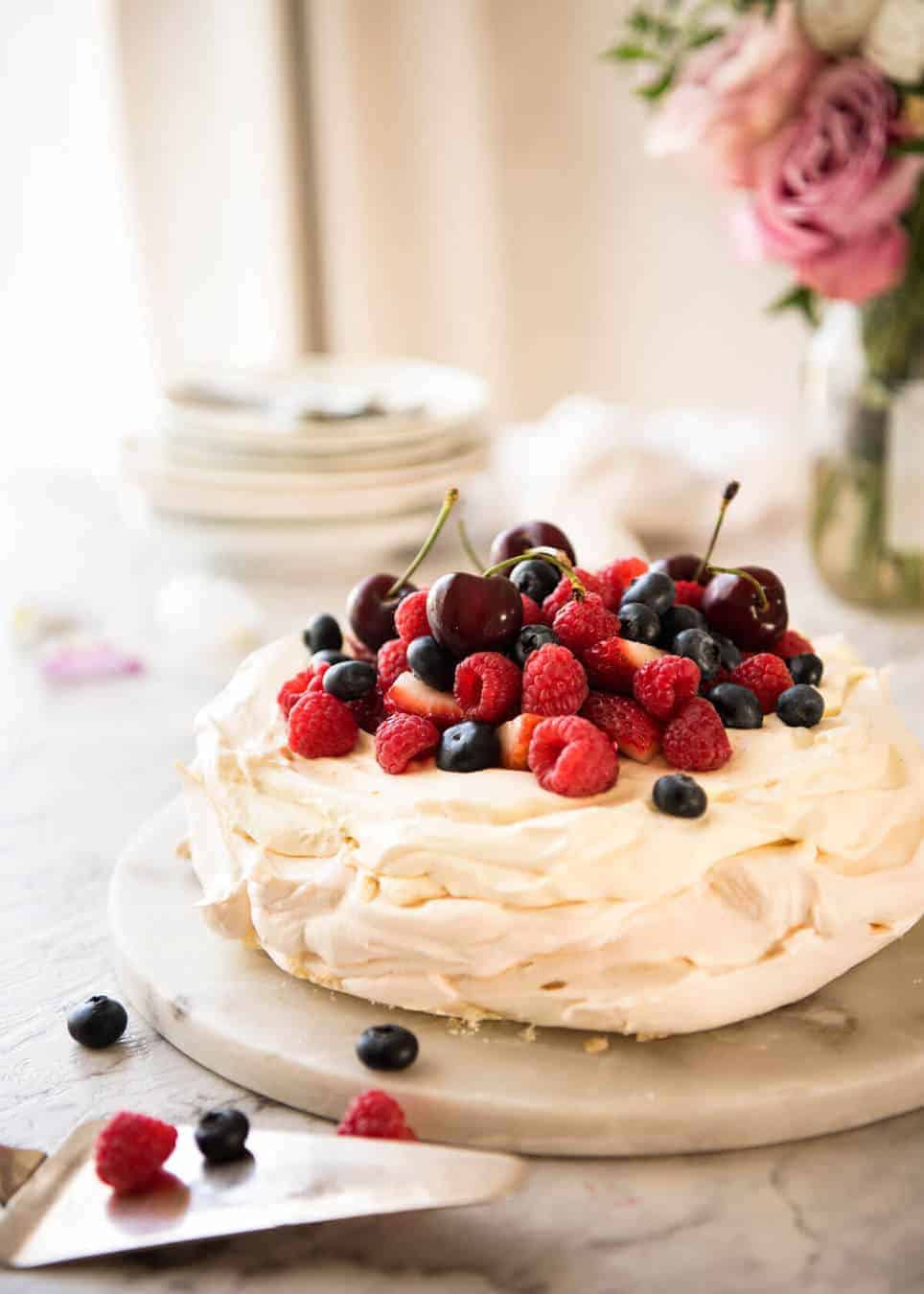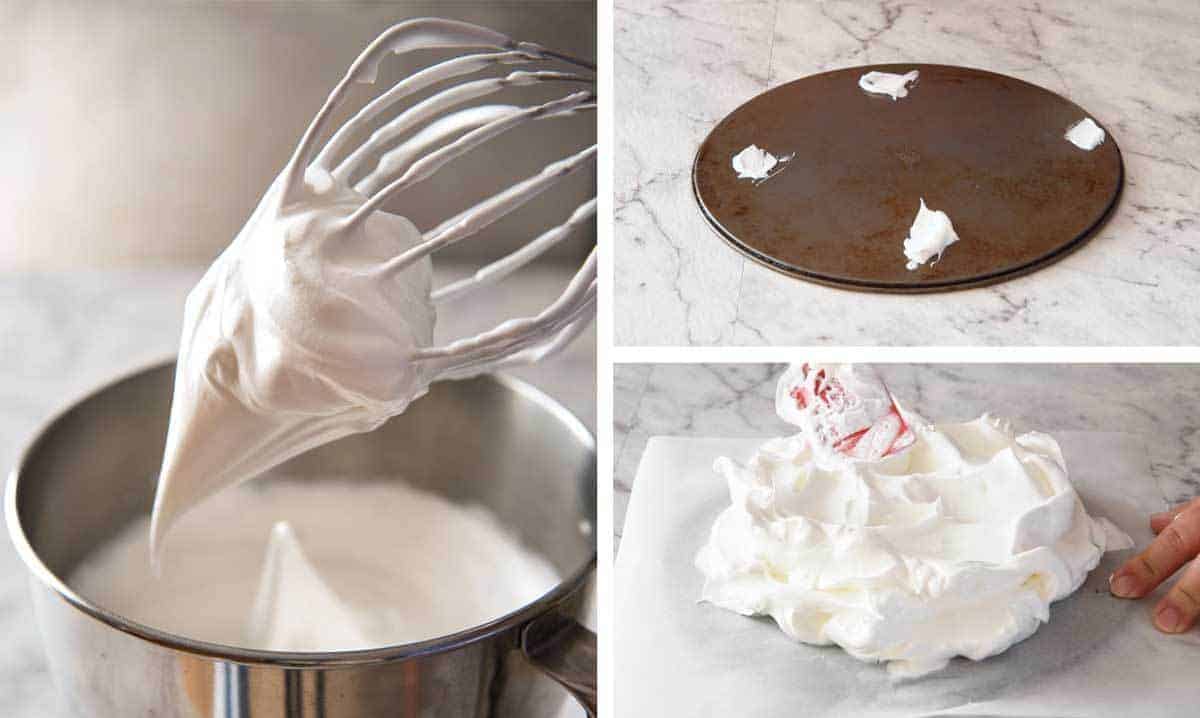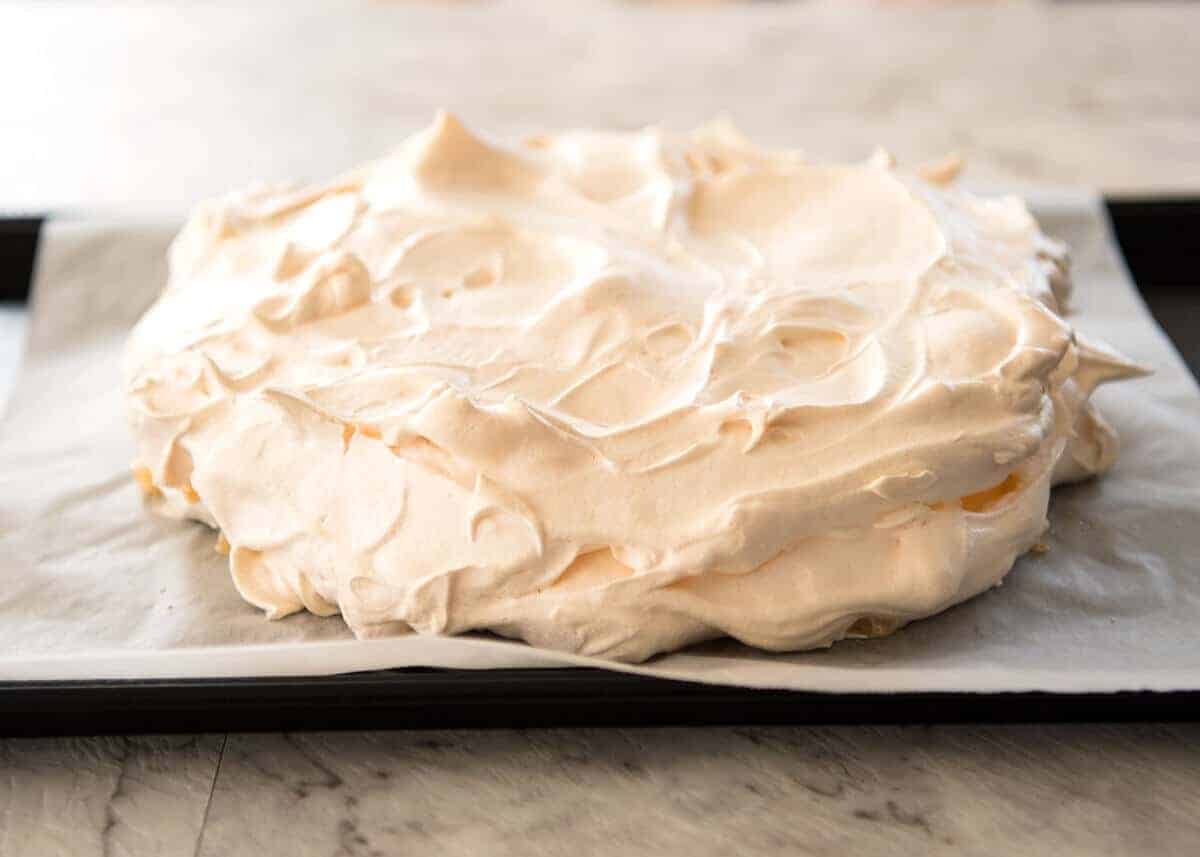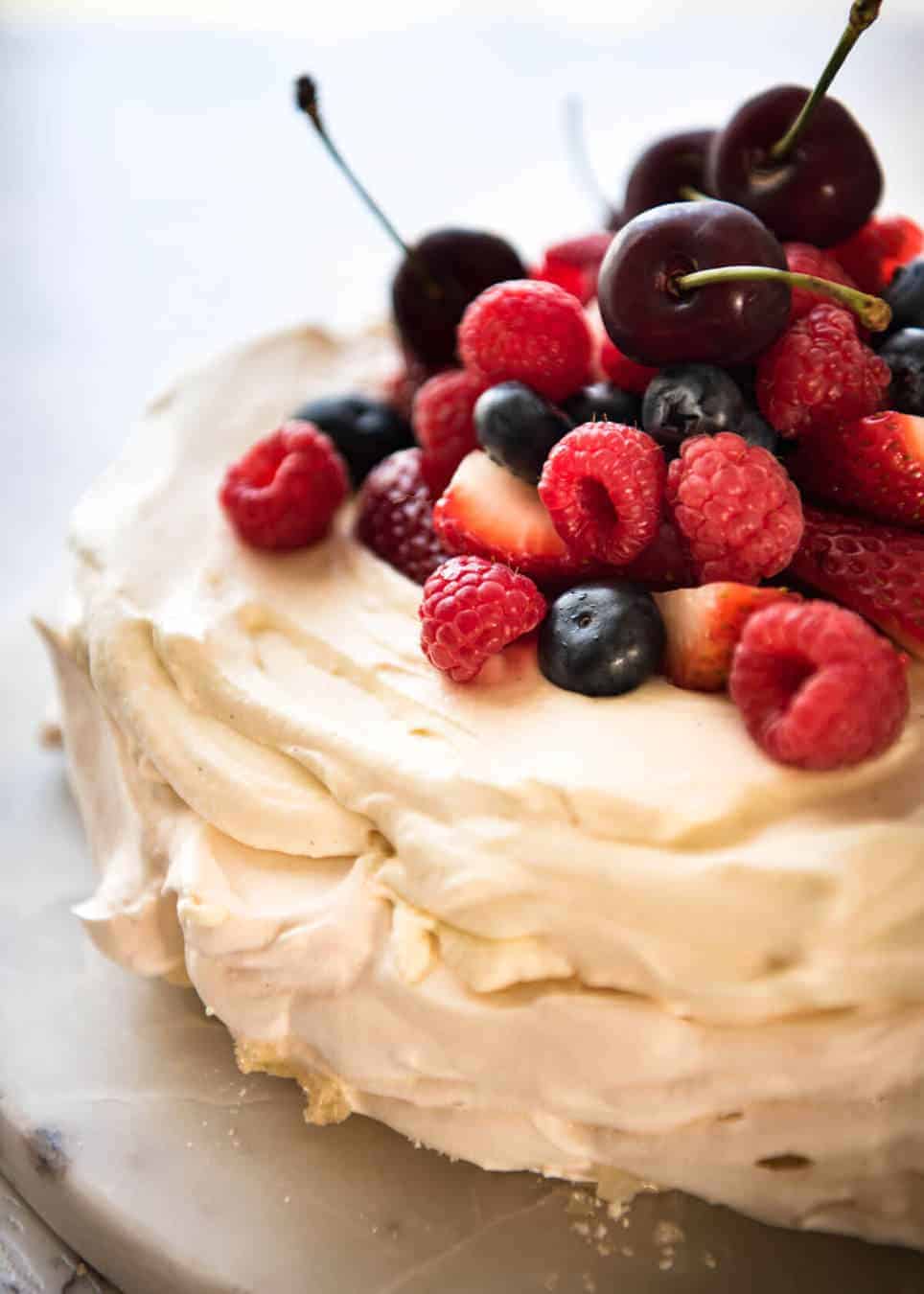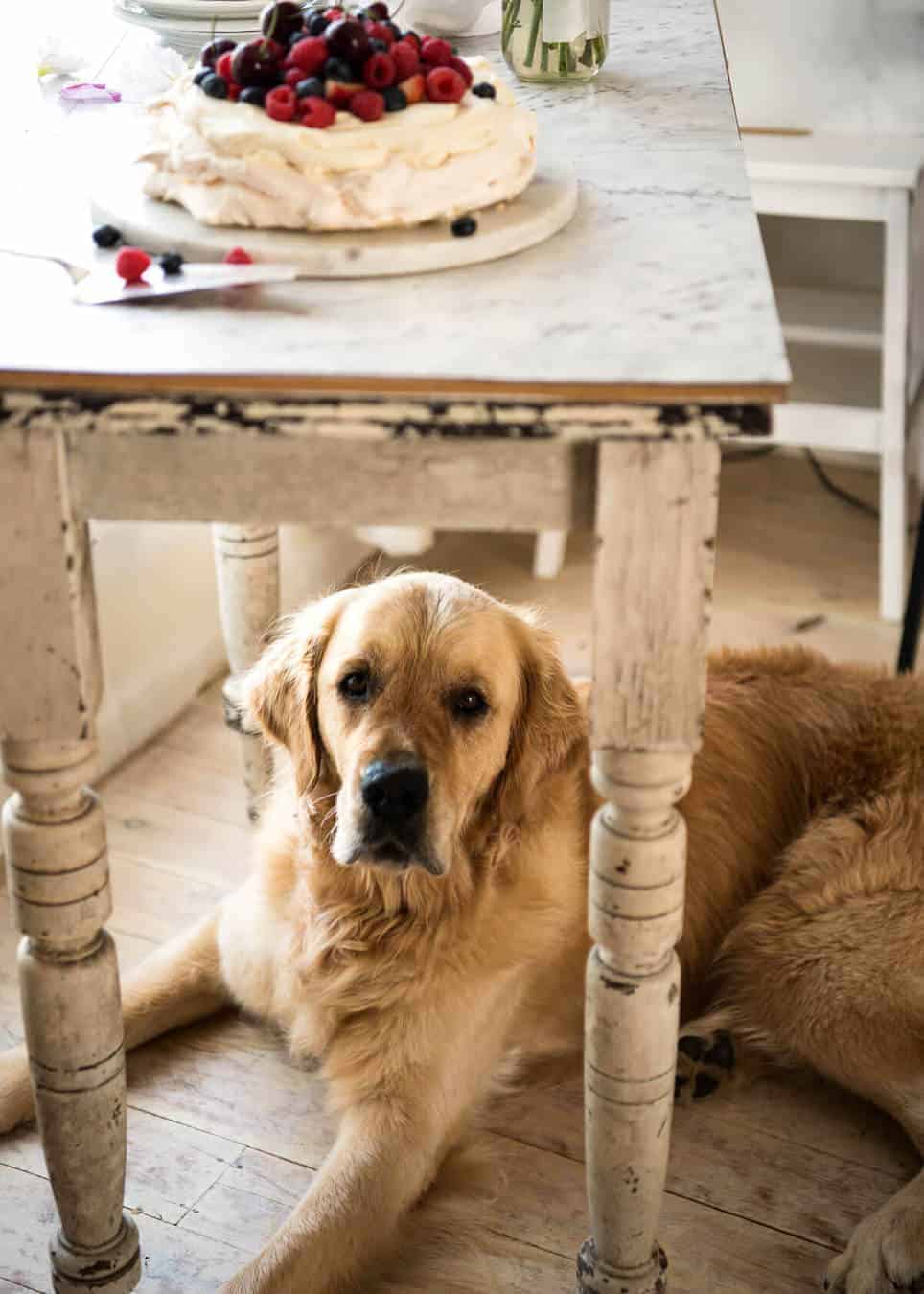With a delicate meringue crust on the outside, soft marshmallow on the inside, topped with cream and seasonal fruit, the pav always steals the show at gatherings!
Pavlova
There is no greater summer dessert than the great Aussie Pav! Pavlova is one of those desserts that is notoriously easy yet notoriously difficult. I think many people are scared to make it. Others have lamented that you should just accept that it will come out of the oven quite cracked. Though I’m going to be sharing my tips for a perfect near-flawless pav (including a few you may have never heard of before!), first up, let me be clear about one thing – it does not matter if it cracks!! Even if it cracks severely. Just do your best to piece it back together, using cream as a glue and to hide the worst cracks. It only needs to hold together for you to place it on the table, for everyone to ooh and ah over it, for you to have your moment of glory. The minute it gets cut to serve it up, it doesn’t matter. Even a perfect pav looks like a mess once it starts being served! But as it so happens, if you follow my tips, I’m confident you’ll have a crack-less near-flawless Pav… 😉
With the recipe video and my secret tips, this Pavlova recipe is easy to follow and you’ll nail it every single time!
Tips for a perfect pavlova
I’ve seen many “no-fail pavlova” tip lists, but I’ve never seen a list with all of these, mainly because some of them are my own, discovered after many trial and errors!
Measure the egg whites by volume. This is a big tip! “4 egg whites” can range from anywhere between 100 – 180ml (3 – 6oz) depending on the size of the eggs + how much egg white you manage to get out of each egg. The amount of egg whites used is key to a successful Pav!
Don’t use freshly laid eggs. Really, older eggs fluff up better! Make sure the eggs are circa 5 days+ old. Store bought eggs are a safe bet. 🙂
Separate the eggs while fridge cold. Trust me, it’s so much easier than when they’re at room temperature. PS If you’re new to separating yolks from whites, just crack the eggs into your hand and let the whites slide through between your fingers. Jiggle your hand slightly to get all the whites off the yolk, and you’ll be left with just the yolk sitting in your fingers.
Not even a drop of yolk is allowed! Even a bit of yolk can ruin the whole batch i.e. it won’t fluff up. So if you accidentally get yolk in your whites, you can try scooping it out using a shell (also good tip for picking out shell bits) but if you think there’s any chance it has tainted the rest of the whites, start again. It isn’t worth the risk!
Bring egg whites to room temperature. They fluff up much better. So separate while cold, then bring to room temperature.
Make sure your bowls and whisk are clean and dry. Grease and water can stop whites from fluffing.
Use an inverted cake pan. For shaping (saves you drawing a circle on paper) and also ease of transferring the Pav to a platter. There is nothing sadder than pulling a perfect Pav out of the oven, only to have it crack when transferring it to the serving platter! Tips continued below photo….you didn’t think I was done, did you? 😉
WEATHER WARNING!!! Heat and humidity. As it happens, Pav is a summer dessert but it is not conducive to being made in hot humid weather. It can cause the Pav to collapse during or after baking. I don’t know the exact temperatures and humidity % cut off points and had a number of epic failures before I figure out tips #9 – #13. Using the tips below, the Pav in the photos were made last week during a heat wave when it was 33C/91F and humidity was 65 – 75%. So if it is hot and humid where you are, do not skip #8 onwards, they were created especially for the Aussie summer!!!
Bigger is better….except in summer 😎 I know, I know. You want to do a giant pav. But honestly, for the sake of a Pav that doesn’t collapse on you, stick with 4 eggs. I can’t stress that enough. I’m speaking from experience here, having tried a few 6 egg pavs a few weeks ago. A 4 egg Pav will serve 8 -10 easily. 4 eggs doesn’t sound like much, but this expands. Any larger, and the risk of severe cracking is really high. At least, in hot humid weather. You can do giant Pavs in cooler months!
Don’t make it too tall. The taller the Pav, the greater the risk of collapse / severe cracking. In summer, I wouldn’t go higher than 5cm/2″. It will expand to about 7cm / 2.7″. You can do your taller Pavs in cooler months. 🙂
Make the edges sloped / dome like shape. Yes, a perfect cake-like shaped Pav with vertical smooth edges is pretty. But it’s also the most fragile shape. The shape of my Pav, almost like a dome but with a flat top, is the safest. Having the rugged surface also helps provide stability I find. (Really hoping an engineer reading this can explain why this is so in simple English, this is beyond my capabilities. I just know they are much more stable shaped like this!)
Preheat oven to a high temp, then turn down. The initial high temp really helps to get that crust kick started to stabilise the meringue.
Bake on a very low temp for longer – This keeps your Pav nice and white (so pretteee!). I bake mine at 100C /210f (fan/convection) or 115C / 240F (standard). Also baking for longer at a lower temp again helps with stability (higher temp can cause Pav to puff too fast which then collapses later).
No peeking and no thundering through the kitchen!! Seriously, I am NOT joking. Peeking = loss of heat / door slamming = collapsed Pav. Thundering through kitchen with timber floors (I’m glaring at a certain giant fur ball as I write that) = collapsed Pav.
Leave in oven overnight. Or all day. Letting it cool down gradually = less cracking risk. Also in summer, especially on hot humid days, where better to leave the Pav than in a sealed almost-airtight oven?
BE GENTLE when topping the Pav! Hanging my head in shame. I once tipped a bowl of strawberries on a Pav and watched in dismay as it sank. Place the topping on gently by hand.
Make extra cream. No, not for serving. To use as glue / disguise cracks / in case it sinks. Remember the beauty of the Pav – even in a severely destroyed state, it can still be made to look pretty with cream and fruit! Follow those tips for my Pavlova recipe, and this is what will come out of the oven even on a 33C/91F day – a near perfect Pav. 🙌🏼
Top with cream and berries, or whatever fruit you want! I totally forgot to put passionfruit on this. I do feel like passionfruit and Pav is just quintessentially Aussie!
And that moment when you place if on the table, when everyone oohs and aaahs over the beautiful Pav…lap it up. You totally deserve it. 😉 Marshmallow on the inside. The softest most delicate meringue on the outside. Smothered in softly whipped cream and piled high with fruit… I truly cannot think of a great Aussie summer dessert. – Nagi x PS. If it’s Christmas time however, you can take Pavlova to a whole new level – literally – with my showstopper Pavlova Christmas Tree!
More Aussie favourites
Scones – and Lemonade Scones 3 ingredient shortcut scones! Pikelets Caramel Slice Lamingtons Sausage Rolls Party Pies
Watch how to make it
Pavlova recipe video! Excuse the lighting and colour balance, it’s all over the place because it was filmed over a couple of days. 😇
LIFE OF DOZER
Waiting for the Pav to fall on the ground….
SaveSave
